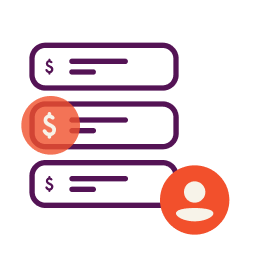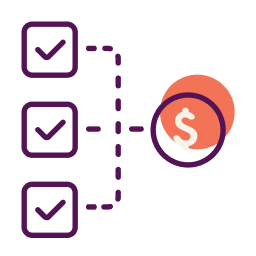If you’re in the market for a small business loan, you’re preparing for a fair bit of paperwork and time spent working with the lender to hopefully get approved. A survey by Nav showed that small business owners spent 33 hours applying for credit with an average of three applications filed with three institutions. Before going into such a time-consuming process, you need to know what you’re getting yourself into. Start by checking your business credit score (you can do so for free with Nav), and see where you stand before beginning the application process.
Any lender will want peace of mind knowing that their borrower is capable of repaying the loan, but how much revenue do you need to get a business loan? As you might expect, the answer is “it depends.” Here’s some insight.
Why Revenue Matters With Small Business Financing
Having a positive revenue stream proves to lenders that you have enough cash on hand to make the loan payment — including the added cost from the interest rate. Business lenders want to see that your small business can handle your monthly payment, which depends on the repayment terms it offers, the loan amount, your credit history, and the type of loan that suits your business needs.
Some small business financing options like short-term loans, invoice financing or equipment financing (which are asset-based loans), and business credit cards may not care as much about your revenue as traditional loans. Traditional funding options tend to take revenue on your balance sheet and profitability on your tax returns into consideration before approving a loan application.
A Hard Number
You’re here for a hard number on revenue requirements for a small business loan. While every lender and every loan will be different, there are some general figures that can give you a guiding hand. A good amount of lenders may only require $10,000/month in revenue to consider approving the loan. Many, however, could require around $30,000/month and higher. Again, every situation is unique, and these are very general figures.
Note: Some small business loans look into annual revenue, which shows up on your financial statements. Others look at your profitability, which shows up on your annual tax revenue. It’s important to determine which number the lender needs before applying.
Is It Possible to Get a Business Loan With No Revenue?
It is possible, but you might have to look outside of traditional bank loans. Term loans can be challenging for a business with no revenue to qualify for since they may have more stringent small business loan requirements than some other lenders. These loans typically require you to have positive cash flow you can demonstrate in bank statements from a business bank account, along with a business plan and established business credit scores.
However, you can look into small business loans from online lenders or startup loans. These short-term financing options are more willing to lend to new businesses or businesses with less revenue. Your creditworthiness may be less of an eligibility consideration, as well, so entrepreneurs and small businesses can be more likely to get accepted.
What Type of Small Business Loans Are Best for Your Revenue Level?
There are many types of financing available to businesses, so it can be helpful to see a breakdown of what is best depending on your revenue level. Here are some of the best options depending on how far your business is in its journey.
New business funding
- Business lines of credit: A business line of credit gives you a limit you can spend up to, but rather than receiving a lump sum, you borrow only what you need. Then you can pay that back and borrow more when needed, which lowers your interest paid.
- Microloans: Microloans are loans up to $50,000, so they’re used for smaller projects or business needs. Repayment terms can be up to seven years.
- Asset-based loans: These loans include equipment financing and invoice financing. They are funding offered for specific purposes, like to buy business equipment or pay upfront for overdue invoices.
- Business credit cards: Business credit cards can help fill in smaller gaps in cash flow and may be easier to qualify for than other funding options.
Established business funding
- Any of the above: All of the loan options mentioned above can act as helpful tools in the toolbelt of any business, established or not.
- Traditional bank loans: A traditional bank loan can be easier for an established business to qualify for. They have more stringent requirements on things like revenue and business credit but may offer lower interest rates and better repayment terms.
SBA loans: The Small Business Administration guarantees its small business loans with excellent rates and repayment terms, but it’s very challenging to get these. You have to have a very established business with excellent revenue before you can qualify.
Debt-Service Coverage Ratio
Because requirements will likely vary from loan to loan due a variety of changing factors, it’s important know what requirements your lender might be looking at. One key factor dealing with your revenue is Debt-Service Coverage Ratio (DSCR). Your DSCR can be measured, generally, as Net Operating Income/Total Debt Service; or, essentially, the amount of money you receive for every dollar you spend. Revenue is important, but how you get your revenue is equally important to your lender.
This is an added requirement to business loans, whereas personal loans may only examine your Debt-to-Income (DTI) ratio. This can simply be calculated as Monthly Debt Payments/Monthly Income. If your monthly payments are $4,000 and your business income is $10,000, your DTI will be 40%. Business loans very well may also examine your business’ DTI ratio, an important product that depends on your business’ revenue. Lenders generally require a DTI ratio from 40%-50%, though there are always exceptions.
Frequency of Payments
Just as important as knowing the gross total of your revenue, debt, and the related ratios, your lender will also want to know the frequency of payments of both. Having $30,000/month in gross revenue is great, but how are you receiving that? Receiving ten payments of $3,000 is likely far better than receiving one payment of $30,000 in the eyes of your lender.
Additionally, knowing how many credit lines you have on your credit report, or how many different vendors or debtors you’re paying each month is important. By expanding your portfolio of clients and getting more income from more people each month, your profile will likely stand out better than otherwise.
In any situation dealing with credit, taking a more holistic approach will pay off for you. Bringing in a higher amount of revenue each month is great, and it’s better if it’s coming from more people. A lower amount of debt will always reflect well in front of a lender. By using the best business practices possible and building a strong profile, you’ll increase your odds of obtaining favorable financing.
The Bottom Line
Financial institutions may want to see your monthly revenue before they extend funding to your business, but it’s often not the only consideration. Other influential factors may be your personal credit score, the number of years in business, and whether or not you have collateral to offer. Your business credit score may also be considered.
To find the best funding options for your small business, creating a free Nav account is the easiest way. Simply enter details into your account and we will do the work to find the funding you’re most likely to qualify for.
This article was originally written on June 26, 2018 and updated on February 8, 2023.



Have at it! We'd love to hear from you and encourage a lively discussion among our users. Please help us keep our site clean and protect yourself. Refrain from posting overtly promotional content, and avoid disclosing personal information such as bank account or phone numbers.
Reviews Disclosure: The responses below are not provided or commissioned by the credit card, financing and service companies that appear on this site. Responses have not been reviewed, approved or otherwise endorsed by the credit card, financing and service companies and it is not their responsibility to ensure all posts and/or questions are answered.